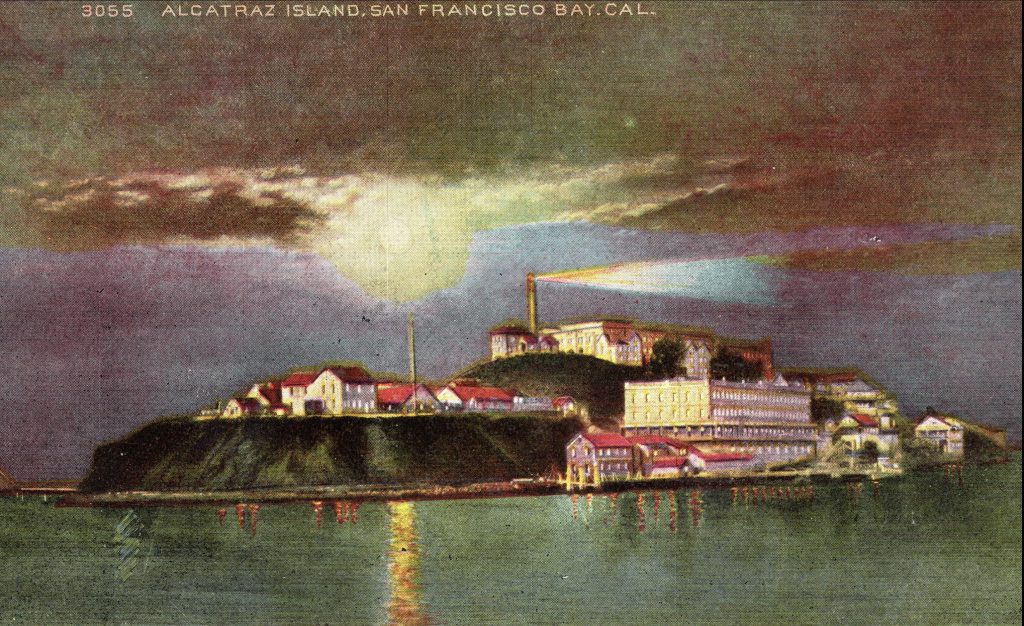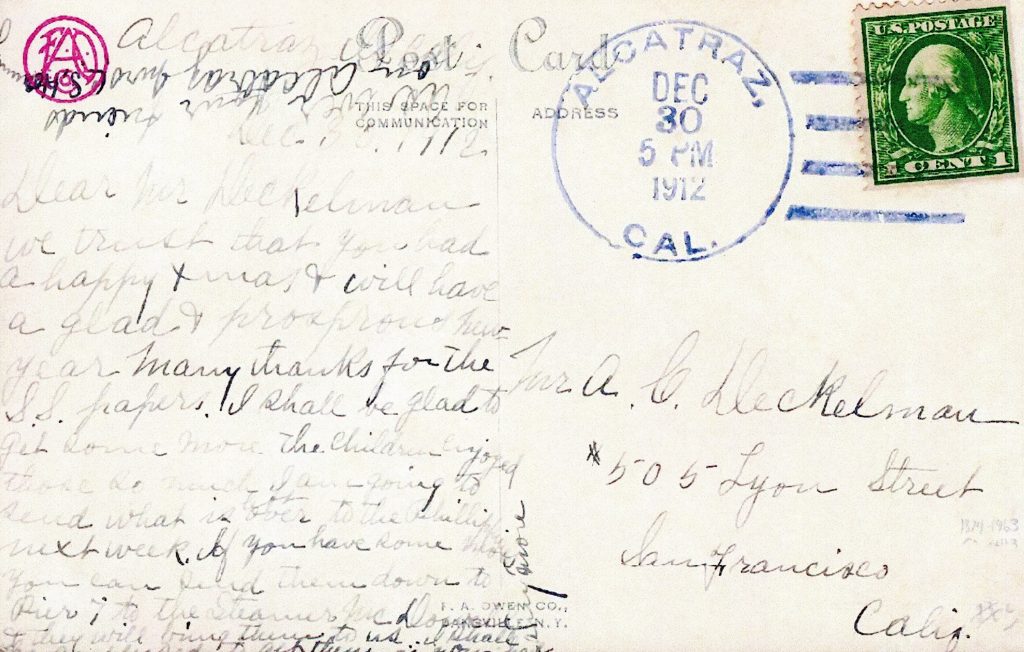What place in America had a U.S. Post Office for almost 90 years, had been pictured on thousands of postcards, yet had almost no postcards mailed from there? The answer is Alcatraz, the island in San Francisco Bay, California.
A U.S. Post Office was established on Alcatraz in 1874 when the island was a U.S. military fort and was disestablished in 1963 when the federal prison closed. In that time period, the island’s use changed from a fort (1874-1907) to a military prison (1907-1933) to a civilian prison (1934-1963). Alcatraz was continually occupied by soldiers until 1933 and civilians until 1963. The civilians included contract workers during military years, correctional officers and their families during the civilian prison years, and lighthouse keepers during both periods.
Postcards of Alcatraz fall into two general types: “geographical” and “focused.” The geographic type show images where Alcatraz, often seen from a distance, is included but not the focus of the picture. In the geographic type, there are subcategories of a general San Francisco city view and a San Francisco site view.
Examples below are the geographic type. The aerial view of the city, cargo piers and the Oakland Bay Bridge in the foreground, and the orange piers of the Golden Gate Bridge in the background and Alcatraz is visible in the Bay on the upper right side of the photo. A second example is an advertising postcard for a Fisherman’s Wharf restaurant, with Alcatraz visible behind it.
Focused type cards show Alcatraz, and any other image is peripheral. In the focused type, the subcategories are identified as “water-level” and “aerial” view. Both occasionally show other land views on the surrounding shores of the bay. Examples below show the skyline of San Francisco in a background, and the Golden Gate Bridge and Sausalito.

Over time, changes in the images on focused postcards often illustrate the changes in the structures on Alcatraz. This card shows a water-level view of the island around 1905. Visible in the middle of the island at top is the original 1854 “cottage style” lighthouse. Behind that, underneath the flag, is the original citadel, the main fortress building on the island, and the building originally used to house military or military-controlled civilian prisoners. At water-level right of center are the original structures around the landing dock area. These include the two-story Building 64, of which the lower brick portion was part of the fortifications protecting the bay, and in the 1860s one level of military barracks was built above.

This postcard was mailed in 1915 during the Panama – Pacific International Exposition. The most prominent change on Alcatraz in this image is the new taller lighthouse, built in 1909. This was needed because of the new three-story jailhouse blocked the beam of the original lighthouse. During that time, the facility kept between 200 to 600 prisoners. Also visible is the conversion of the Building 64 military open-plan barracks into a three-story apartment building. Additional work included the 1910 construction of a Post Exchange building, visible as a water-level building with three window-arches on the far-right side. This is notable because in 1915 the post office was moved to the Post Exchange Building.

This aerial view postcard shows the west side of the island. The most prominent feature here is the open “parade ground” on the right. From 1870 to 1876 there was a plan to level the island and construct bombardment-proof underground bunkers and tunnels, but only the southern tip was leveled. In prior years, this area held workshops, mess halls, prison libraries, and other support-service buildings. By the mid-1920s these had all been cleared away. On the left a smokestack is visible that is part of the power plant, laundry facility, and prison workshops. This postcard was mailed in 1927.

This ariel view shows the west side of the island around the early 1950s and reflects the construction that occurred since the Army had transferred Alcatraz to the Department of Justice for use as a federal prison.
At the left to the right of the smokestack is the Quartermaster Warehouse, notable for the word “ALCATRAZ” on its roof. The warehouse was built in 1920 for storage of supplies; it included a garage and offices. To the left of the smokestack, on the end of the island is the Model Industries Building; it contained a group of workshops for training the prisoners, a band room, and a laundry built by the US Army in 1922.
Moving to the right, the long 2-story building along the island’s edge is the New Industries building that contained a dry-cleaning plant, and furniture and brush factories where prisoners could work to earn money for use in the prison commissary. The second floor was a laundry. On the other side of the island was a 94-foot tall water tower, capable of holding 250,000 gallons that was built in 1940, as a practical and cost saving matter. Alcatraz has no natural source of water, and prior to this water had to be delivered daily by boat.
Another part of this image shows several multi-story residential buildings. The building at the farthest end was quarters for the associate warden and captain of the correctional officers. The other three buildings on the lower edge were new apartments built in 1940 for the non-inmate residents.

Returning to the opening question, these two postcards were mailed from Alcatraz. The first is a jumbo-card mailed in December 1952, during the federal prison years. From the message, this card was mailed by a relative of a correctional officer, with whom the sender was visiting for Christmas. Because this was an oversized postcard, it required 1st class letter postage.

This is a Happy New Year card that was mailed in December 1912 during the military prison years. In the message, the sender writes that his children, upon receiving the “S.S. papers”, …enjoyed them so much. … If you have some more, you can send them down to Pier 7 to the Steamer McDowell and they will bring them to us.”
The General McDowell was an Army quartermaster steam-propelled vessel that was the main mode of transport to Alcatraz Island during its function as a military defense and war camp. Delivered in November 1886, the ship carried soldiers and inmates, military supplies and water between San Francisco, Fort Mason, the Presidio, Alcatraz Island and Angel Island.
In 1963, the decision was made to close the prison on Alcatraz, based on the cost of operations. Having no natural resources, all food, water (a million gallons each week), and other supplies had to arrive by boat. In addition, the salt water atmosphere had taken its toll on the main jailhouse as well as other buildings. Also there was approximately three to five million dollars in maintenance work required to continue safe operations of the prison. Combined, these two factors made it an easy decision.




very interesting and well written.
Excellent! Thank you.
Thanks for this great article with a different slant on Alcatraz. I collect prison postcards, and especially appreciated your sharing some of the messages written on the cards. Kudos!
The word alcatraz is Spanish for “gannet” or “pelican”.
Interesting history of an iconic American institution. Have passed by it but hope to one day make an
actual visit.